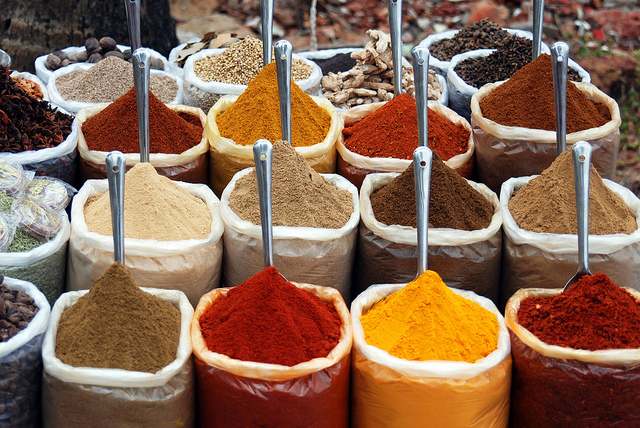
Curry’s Common Ground
By Mary Petiet
The man behind the counter glances between the potent spice mixes and my ten-year-old son.
“You like this?” the man asks in a heavy Pakistani accent. He starts ringing up the sale, and cultures connect as my blond towhead grins widely and tells him he loves curry.
When I was ten years old, I had never tasted it. Curry had not yet arrived in our small Massachusetts town, although I had heard rumors of it from my English cousins. Until a few years ago, I had to go into Boston to shop for Indian food.
Now, masala, korma, Punjabi chana, and fish biryani; vibrant spice mixes neatly packed in small boxes stamped “Made in Pakistan”: I wonder at their journey to the new storefront on our town’s main street and marvel at how easily they create amazing Indian dinners. The man behind the counter asks if I know how to cook with them. I recall tasting my first curry as a college student in Scotland in a restaurant promising the cuisine of the Mughal emperors. It made my eyes water and my nose run and I loved every bite of it. Awash in the new spices and always a cook, I asked the waiters, “How do you make this?” “Madhur Jaffrey’s cookbook,” they replied unanimously.
In the store, I regard the man over a box of frozen samosas. The store smells of curry in the way of all Indian markets. As my son runs back for a jar of chutney, I tell the man it took me years to learn how to cook this stuff, starting with a recipe called Malaidar unday in a dog eared copy of Madhur Jaffrey’s Indian Cooking.
Malaidar unday is a simple curried egg recipe and as I cooked it I realized that at its base, Indian cooking has a balanced trinity of flavors: ginger, chili and onion. Over the years, I learned to grind spices and puree pastes, and to add yogurt slowly so it doesn’t curdle. I spent hours filling the kitchen with potent smells from far off places and piling our plates with the spicy stews my son has grown up eating.
The man takes the chutney from my son and tells us his favorite is butter chicken and that the butter chicken spice mix feeds a lot of people. My son says he loves that one, too. We share stories of big butter chicken meals, agreeing there can never be too much of it. The man shakes my son’s hand, we walk out the door, and the fresh air hits us as we leave the smells of Pakistan behind.
Out on the sunny sidewalk, I seize the moment to connect cultures. I ask my son if he has been hearing a lot of scary things about Muslims recently. He says he has: terrorism, the refugee crisis, a possible registry. Just as I have feared, the vitriol has not escaped my child, hate does not happen in a void.
“That man in the store is a Muslim,” I tell him. “He’s from Pakistan, and he likes a good curry just as much as we do. Think of how the different spices in the curry work together to form the coherent whole of the dish. People are like that. We can work together to form a successful whole. The Koran says: Do unto all men as you would wish to have done unto you. Jesus also says: Do to others what you want them to do to you. We have common ground, and we can’t vilify an entire people based on extremists—just as we can’t dismiss all curries as bad when we add too much of one spice to overwhelm one dish.”
When we get home, we break out the butter chicken. I imagine the chicken floating in the marinade as the continents floating in the ocean, and the spices as the people and the animals inhabiting the land and the sea. Later, while the mixture simmers, I watch as it all comes together in a vibrant, balanced, colorful mass, connecting us to each other as surely as it connects us to the greater global mosaic.
Mary Petiet is a reporter, writer and storyteller. Her book Minerva’s Owls is forthcoming from Homebound Publications in April 2017. Visit her website, www.marypetiet.com, and follow her on Facebook.
Editor’s note: Learn more about Madhur Jaffrey, “The Queen of Curries,” and try a few recipes found here.
Photo credit: Sara Marlowe via a Creative Commons license.

Wonderful mix of spices, religion and politics, culminating in an aromatic message.